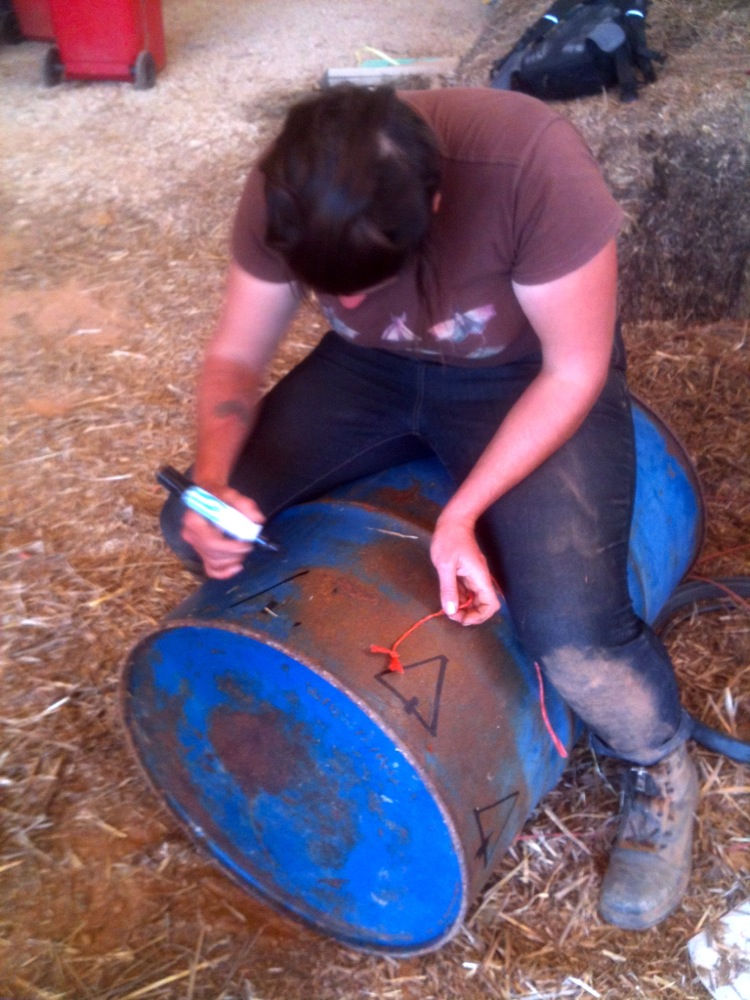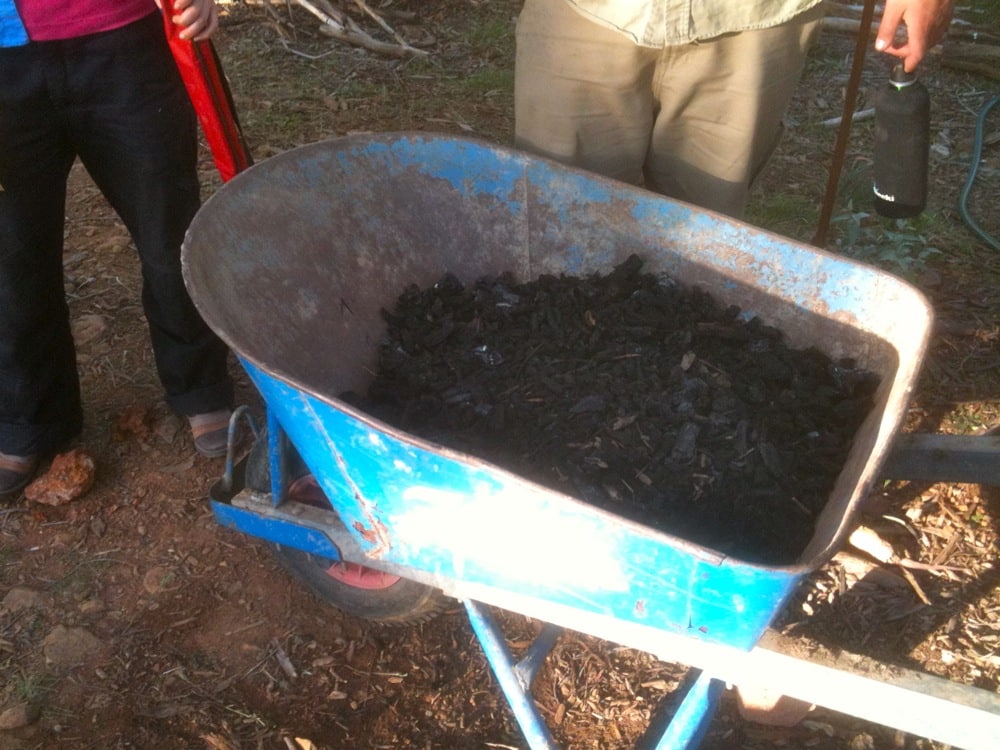
Biochar is a type of charcoal, made and used for specific purposes – most often as a soil amendment.
To make Biochar, you burn biomass using pyrolysis – a low/no-oxygen burning environment that prevents combustion of the biomass material, and therefore produces charcoal.

Clockwise from the top: biochar made from cardoon seed head, apple tree prunings, corn cobs, bone, bamboo, lumber ends, rabbit droppings in center – photo by Harley Soltes
The attributes of biochar as a soil amendment seem pretty significant – it’s like adding small, stable sponges to your soil – they don’t break down easily (with good soil management) which means the biochar can provide more habitat for the soil food web, as well as help holding water and nutrients in place.
And then there’s the carbon factor – most of the carbon in the biomass (which might be wood, woodchips, horse manure or whatever) is still present in the biochar and stays there.
Which means when you put that carbon in the ground, its’ sequestered there for the next few thousand years in a stable form, and not out there in our atmosphere where we clearly don’t need any more of it just now thanks.
So. Soil wins, the atmosphere wins. Great. But the process of making biochar involves burning, which means there’s heat energy available. How can we make use of that and stack some functions?
Answer: a biochar stove – combining a DIY biochar kiln with a cooktop.
Here’s what we’ve come up with so far:

Kel marks out the triangles for the base of the outer drum


Gigi makes out the hole for the top of the outer drum

Biomass in inner drum, getting ready to burn

Dan ready to light the biomass



Once it’s burning well, on goes the top

Bricks to create a stove top

On goes a big pot of water


And the end product

Biochar!

Read to add to Milkwood soils
This design was constructed by Dan Harris and the Milkwood crew, and is based on the Dome School’s tin can biochar stove (scaled up a touch, obviously).
The dome school has done some great work on biochar so do check out their resources.
Kelpie Wilson, the driving force behind the above stove design, also has a teachers guide for a 3 can Top Lit UpDraft pyrolytic gasifier, which is a similar design without the stove top.
The adding of a stove top (of sorts) and boiling water on top during the biochar process worked very well, and the big drum of water was boiling in a MUCH shorter time than would be expected from heating it with a normal fire.
So our thinking at this point for biochar is that we’ll make it as part of the process when we need to boil big amounts of water – during mushroom production for example, when we need to sterilise a heap of substrate before inoculating it.
Another couple of options will include prepping the scalding water for processing chickens and pigs on-farm.
This way we get hot water in great quantities (an intermittent need, but a big task) when we need it, and as a byproduct of that process, another load of biochar for our market garden’s soils. All done using two metal drums and scraps of organic material. Seems pretty appropriate to me.
Lastly an note that this is an experimental process! Our goal here is to create a good DIY system that stacks heating on top of biochar making. We prefer to share the process as we go, for everyone’s benefit including ours.
Biochar resources:
- Kelpie Wilson. Heaps of awesome biochar/ appropriate tech resources
- Biochar medley image above from Sustainable Eats
This process is an ongoing experiment, and we’re very open to feedback if you have any, so bring it on.
>> More posts on appropriate technology at Milkwood
Big thanks to Dan Harris Pascal for getting this project up and rolling, and to all the Milkwood crew who helped make it happen.














Taranaki has a colourful biochar history. Apparently, in the spot above where our first keyline dam was installed, there used to be a camp site where two charcoal producers lived for a time. As the story goes, their partnership was short lived after one of the two shot the other following a disagreement! During the dam excavation we found quite a bit of remnant terracotta – obviously produced during the burning process.
Great post… waste not, want not.
We’ll try not to shoot each other in the process. Thanks for the tipoff.
Charcoal is not the same as Biochar.
Biochar is biomass that has been burnt in low oxygen conditions (Pyrolisis) below about ~500C such that only the volatiles are removed leaving the heavier tars in the charred biomass.
Charcoal is biomass that as been burnt in low oxygen conditions above ~600C, typically at 1000C such that only a charred biomass carbon structure remains.
Biochar is better at holding water, providing a hospitable environment for essential micro-organisms and hence storage of minerals.
http://www.biochar-international.org/biochar
Yes, but as that site itself defines: “[the biochar] process often mirrors the production of charcoal, which is perhaps the most ancient industrial technology developed by humankind. However, it distinguishes itself from charcoal and similar materials by the fact that biochar is produced with the intent to be applied to soil as a means to improve soil health, to filter and retain nutrients from percolating soil water, and to provide carbon storage.” … so… how is biochar not charcoal if it’s made by ‘a mirroring process’? Seems to me it’s therefore charcoal (albeit a certain type), made in a particular… Read more »
I’ve been making biochar for my vegie garden for some years. I make it in winter when we are using our wood space heater. I use a large Milo tin with several nail holes punched in the lid to let smoke and pressure out. These holes MUST be made otherwise the can could EXPLODE or at least pop off the lid with a loud bang. I fill the can with a mixture of sawdust and horse manure from the stables. Pop the can in the heater when I go to bed and in the morning I have biochar. The smoke… Read more »
Hello Great work I was wondering when Milkwood might catch on. I am so glad you have as biochar is a multi disciplined tool for permaculture and preppers. Another great Australian resource is Biocharproject.org they have many other designs and outside the box concepts. A biochar pilot industry that has won govt recognition is all helping to spread the word biochar. It should be the peoples tool and do not let others try and tell you otherwise. In reality Biochar is charcoal that you use in the ground as a soil amendment and or home for microbes. The scientist are… Read more »
brilliant story
just goes to show that the Ancients really knew their stuff (as if there was any doubt) when it came to burning their fields and Amazonian ag techniques)
thanks for posting this
i’ll be doing this later this year
i wonder, have you considered cooking down maple sap with this system?
i’m not familiar enough with Australian ecosystems to know if there are any sap producing trees there, well, any with a high enough sugar content to be a source of syrup
keep it up
Sorry just a newbie question… My hubby has a wood burning outdoor stove thing and a wood heater in the garage. Can i just add the charcoal from that in the winter to the soil or am I just being a total noob? Can just wood (and the odd corn cob) be considered bio mass or does it need to be special stuff that is burned?
yep, charcoal like that would still be of benefits to most soils… especially if you have any berries!
Just wondering why you don’t light a fire in the outside chamber and leave the central chamber partially sealed. Methinks more biomass might be attained per burn.
that is the way I see it too….. I thinkg this should be set up with a rocket heater as the outer can
Hello Mike Wolford to answer your question above Yep someone has already though of that : ) Nothing we think is an original idea it has all been done before. What makes us special is putting what we think into action and from that moment we can begin to create on the foundation until we have created something new. All by trial and error we will generate something truly unique. To see who does rockets with retorts in the middle google Hugh Mclaughlin Jolly rogers ovens. He taught me that 3 years ago when he came to Australia. Lets spread… Read more »
The process of making biochar is a nice one.At the end the colour has been changed.Is there any other method for making it?
I have an idea to use a rocket stove with a biomass “reactor” on top to be placed between the cook pot or water heater. Anyone ever thot o’dat?????? And by the way, what I see here is more like an oven than a biomass “reactor”. no?